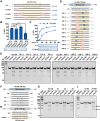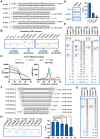SARS-CoV-2 nsp15 preferentially degrades AU-rich dsRNA via its dsRNA nickase activity
- PMID: 38634805
- PMCID: PMC11109939
- DOI: 10.1093/nar/gkae290
SARS-CoV-2 nsp15 preferentially degrades AU-rich dsRNA via its dsRNA nickase activity
Abstract
It has been proposed that coronavirus nsp15 mediates evasion of host cell double-stranded (ds) RNA sensors via its uracil-specific endoribonuclease activity. However, how nsp15 processes viral dsRNA, commonly considered as a genome replication intermediate, remains elusive. Previous research has mainly focused on short single-stranded RNA as substrates, and whether nsp15 prefers single-stranded or double-stranded RNA for cleavage is controversial. In the present work, we prepared numerous RNA substrates, including both long substrates mimicking the viral genome and short defined RNA, to clarify the substrate preference and cleavage pattern of SARS-CoV-2 nsp15. We demonstrated that SARS-CoV-2 nsp15 preferentially cleaved pyrimidine nucleotides located in less thermodynamically stable areas in dsRNA, such as AU-rich areas and mismatch-containing areas, in a nicking manner. Because coronavirus genomes generally have a high AU content, our work supported the mechanism that coronaviruses evade the antiviral response mediated by host cell dsRNA sensors by using nsp15 dsRNA nickase to directly cleave dsRNA intermediates formed during genome replication and transcription.
© The Author(s) 2024. Published by Oxford University Press on behalf of Nucleic Acids Research.
Figures







References
-
- Gorbalenya A.E., Baker S.C., Baric R.S., de Groot R.J., Drosten C., Gulyaeva A.A., Haagmans B.L., Lauber C., Leontovich A.M., Neuman B.W. et al. . The species severe acute respiratory syndrome-related coronavirus: classifying 2019-nCoV and naming it SARS-CoV-2. Nat. Microbiol. 2020; 5:536–544. - PMC - PubMed
MeSH terms
Substances
Grants and funding
LinkOut - more resources
Full Text Sources
Miscellaneous

